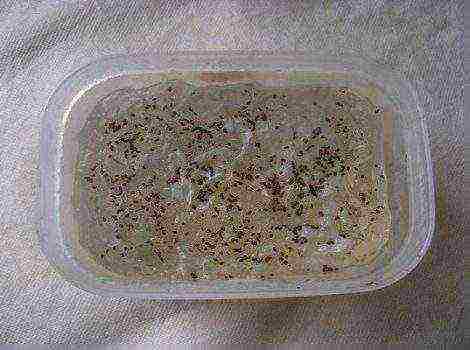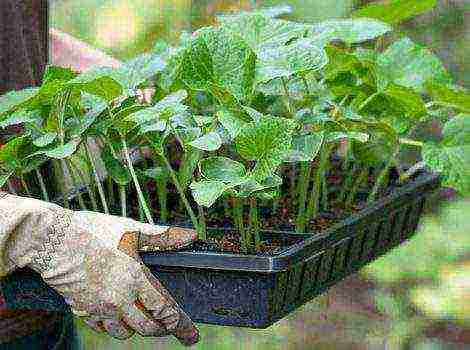Content [show]
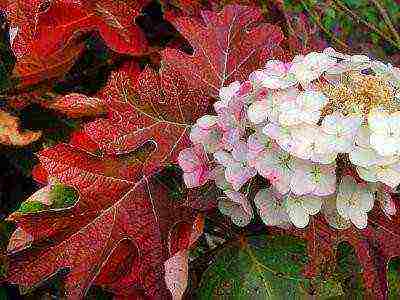
An ornamental shrub that can easily become one of the main decorations of your garden is hydrangea is oak-leaved. This plant comes from North America and is still new to Russian gardeners.
Oak-leaved hydrangea is an elegant, weather-resistant plant that attracts everyone's attention both during the flowering period and outside it.
…
Description
This plant - large deciduous shrub, which can reach a height of 2 m. Its "highlight" - textured, pleasant to the touch, large 7-lobed leaves, the shape of which is close to the shape of oak leaves. Such leaves are the main difference oak-leaved hydrangea from other varieties of this shrub. The edges of each hydrangea leaf are sharp, serrated. Sheet size - up to 25 cm. Fresh shoots and young leaves are covered with a light white fluff, which eventually disappears, remaining only on the seamy side of the leaf.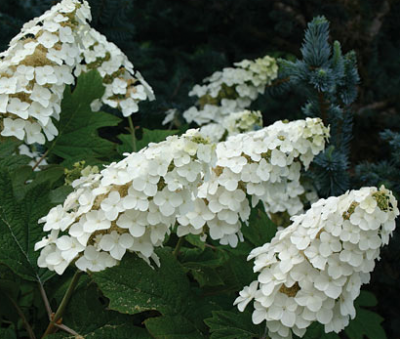
REFERENCE: In the warm season, the leaves of the bush have a dark green color, which by autumn is replaced by a rich crimson, which makes it beautiful even during wilting.
Not only the leaves attract the attention of gardeners to the hydrangea - it is very beautiful blooms... Its flowers are large panicle inflorescences of small white flowers up to 3 cm in size, collected in a cone. The shrub blooms for a long time: from June until autumn.
The trunk of the hydrangea is straight, lignified at the base, well branched. The shrub grows very quickly - in just three years, a gorgeous lush plant can be grown from a seedling, since the shoots have time to stretch out in one year up to 50cm.
The root system is branched, shallow.
Climate
In general, oakleaf hydrangea is a frost-resistant plant, but in central Russia it can freeze slightly without proper care. Winter hardiness zone - up to -29C. This plant thrives best in the southern regions of the country. There are cases when the kursarnik winter well in the Moscow region.
ATTENTION: Young plants should be sure to cover for the winter or transplanted into a pot and kept indoors as an indoor flower during this period of the year. With age, the shrub tolerates the cold much better.
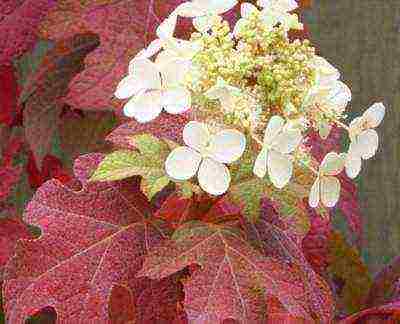
Varieties
There are several varieties of shrub, the two most common are Garmony and Applause.
Hydrangea oakleaf Harmony has spherical or flat large inflorescences with a diameter up to 20 cm... The flower petals are white or cream colored.
Hydrangea oakleaf Applause reaches in height 2 m and has large inflorescences of snow-white color. Sterile flowers are larger than fruiting ones.
Planting and leaving
It is generally accepted that hydrangea is a capricious plant, and it requires complex care. But growers who, in practice, have already dealt with this shrub, argue the opposite.
With proper care, it does not require complex manipulations.
Landing
Planting in the ground is carried out in the spring, while in a hole partially filled with fertile soil - for example, red peat, pine litter; the plant does not plant too deeply, the root system is covered with earth. Around the trunk, the soil should be lightly tamped and shed. While the hydrangea takes root, good watering and shade are important to it.
Priming
This plant is capricious about the ground - hates lime... The shrub should be planted in loose, fertile, drained acidified soil. It is worth acidifying the soil about 2 times a month with fertilizers.Optimal level NS for oaky hydrangea - 4,5-6,5.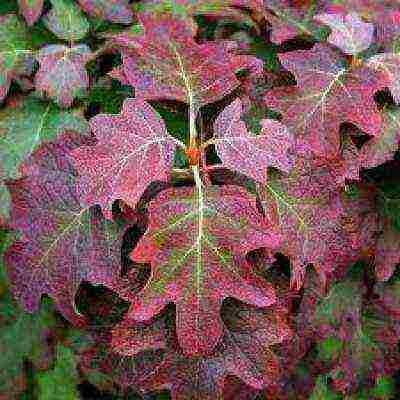
Watering
The soil in which this shrub grows should always be moistened, therefore it should not be allowed to dry out. Helps maintain the required microclimate mulchingwhich is produced annually. It is necessary to water the plant with settled warm water: under one bush - about 3 buckets.
Light mode
> The right place for planting hydrangeas is the key to success. The plant should not be under the scorching rays of the sun. The ideal shrub planting site is a slightly shaded or shady spot in the garden.
IMPORTANT: The amount of light will not affect the flowering of the shrub.
Thermal conditions
Hydrangea is patient with temperature changes, but you should not overcool the plant once again.
Most of all, this plant is afraid of spring frosts.
Fertilization and feeding
So that the plant grows well and pleases you with a lush crown and flowers, it it is important to fertilize correctly both organic and mineral fertilizers with a high content of iron and magnesium. It is important to fertilize the plant in a complex at the time of planting and during active growth, that is, twice a year.
Top dressing is done in late spring or early summer with a complex mineral fertilizer (superphosphate, urea and potassium sulfur in the amount of 20g, 10g, 10g, respectively), then the plant is fed every two weeks until July.
ATTENTION: Top dressing stops in July, as the shoots of the bush should have time to woody before winter.
Do not overdo it with fertilizers, otherwise the inflorescences will become too large and heavy - hydrangea branches can break.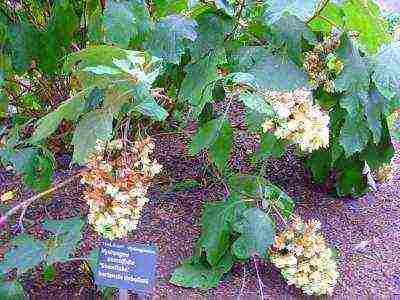
Reproduction
Hydrangea reproduces in several ways: cuttings, dividing bushes, seeds, grafting.
Cuttings Root well in July when the flowering period begins. Rooting takes place within 4 weeks in the presence of optimal conditions - shade and temperature from 16 to 20C.
IMPORTANT: Lignified shoots take root poorly and are not suitable for grafting.
Plant propagation dividing the bush produced in spring or autumn: for this, the hydrangea is removed from the soil, divided into several parts so that several buds of renewal remain on each.
Grow this shrub from seed difficult, but if you decide to try to do this, then try to create all the necessary conditions: the seeds should be sown in a box in the soil of humus, peat, sand, and then regularly water with a spray bottle. If the seeds were sown in the spring, they will sprout in about a month, and by the fall, young plants will stretch up to 40 cm in height.
Pruning
Pruning is done in spring - until fresh leaves have blossomed, all weak, damaged branches are removed from the plant, and powerful shoots are shortened, leaving only 2-3 pairs of kidneys... In summer, the inflorescences that have already faded are removed from the plant - this will make it possible for the young to bloom.
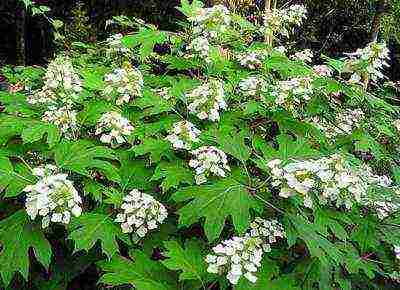
Wintering
It is important for hydrangeas to ensure proper wintering: in the first year of life, a young plant must betransplant into a pot and keep in a warm room. In mid-December, the wintering shrub loses its foliage and retires. During this period, it is worth moving the bush to a dark corner of the room and reduce the frequency of watering... Awakening occurs in April - buds begin to swell on the branches of the bush. During this period, hydrangea needs put on the windowsillso that the plant gets enough light. Watering during this period should be done with the addition of fertilizers to the water. Back to the garden plot shrub lands in May.
In the southern and western regions of the country, hydrangea need not be dug out for the winter, but it is necessary shelter... This procedure is performed in dry weather in the fall - in October-November. The branches of the plant must be bent to the ground and covered with a covering material. The same material or spruce branches are laid under the bent stems.On top of the covering material, it is necessary to sprinkle peat with a layer of about 15 cmcovering it with foil.
ATTENTION: When the time comes to free the hydrangea from the wintering "tent", do it gradually. The bush opens completely only when the danger of severe frosts is over.
Diseases
Hydrangea is a disease-resistant plant, but there are some among them that the shrub cannot cope with - this gray rot, fungal diseases, downy mildew. The reason for this dew is high humidity, it is treated by normalizing the microclimate around the plant.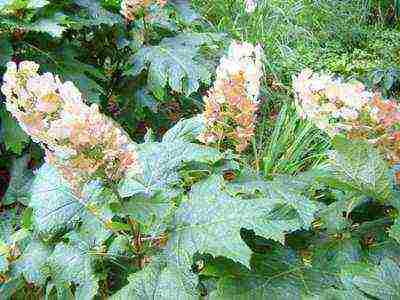
Also the shrub is prone to chlorosis - yellowing of the leaves. Its cause is an excess amount of lime in the soil. It is treated with dressings with iron salts.
Among insects, great damage can be caused by aphids, spider mites, spider mites and weevils... Spraying with Karbofos, Aktellik and other preparations will help get rid of small pests.
With proper care and cultivation, oakleaf hydrangea will delight you with its beauty for a long time - even without flowers, this plant amazes with its richness, showiness and will definitely become the highlight of your garden.
Now this shrub is gaining popularity and increasingly appears in the flower collections of professional gardeners.
Photo
See oaky Hydrangea in the photo:
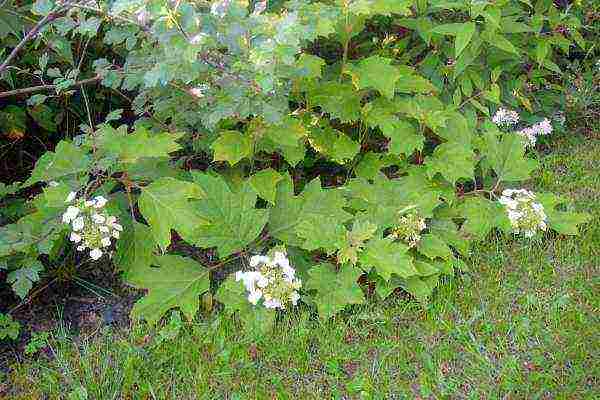

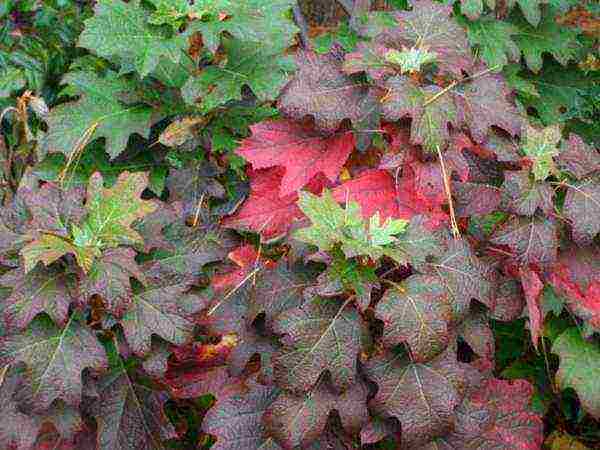
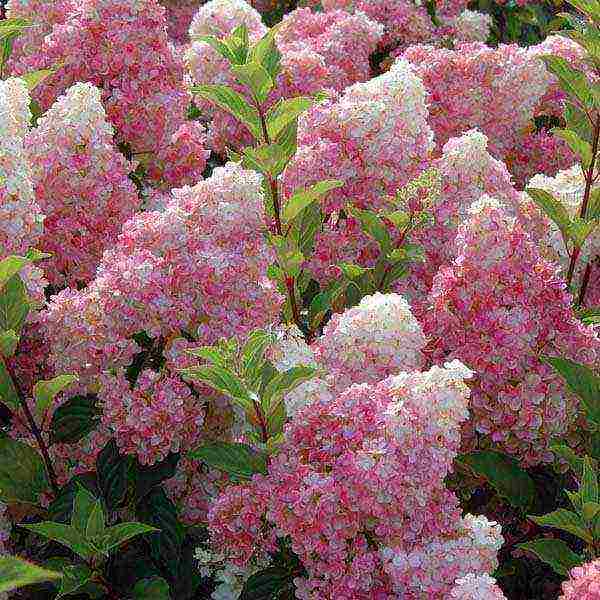
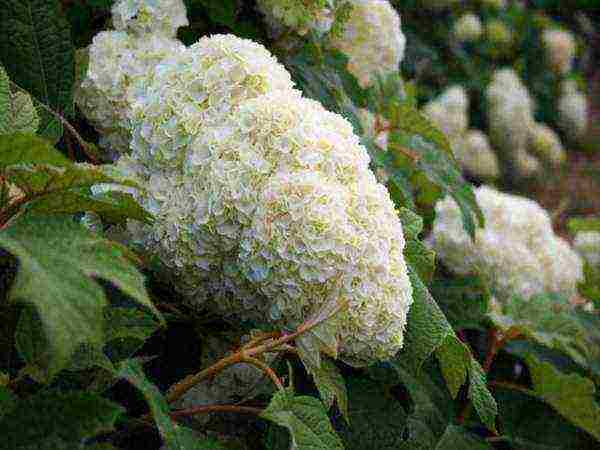
Useful video
Watch the video and find out how to plant oaky hydrangea:
Oak-leaved hydrangea is a very rare deciduous shrub that sometimes grows up to 2 m in height. It is named so in the shape of leaves, very textured and rough, very similar to oak. But unlike oak, the edges of the hydrangea leaf are pointed, with notches, with a maximum length of up to 25 cm.
The plant is considered one of the finest flowering species native to North America. Hydrangea can add luxury and charm to any garden plot - as a solo planting on the lawn or as a charming hedge. The hydrangea growing at the front doors looks really beautiful.
Oak-leaved hydrangea is not a frost-resistant variety, and reliable protection for the winter period is required. The attention of gardeners is attracted by magnificent delicate inflorescences with carved flowers, as well as long flowering, from early summer to autumn, and dense foliage rich in various shades, acquiring a rich red color in autumn.
Oak-leaved hydrangea is a very rare deciduous shrub that sometimes grows up to 2 m in height. It is named so in the shape of leaves, very textured and rough, very similar to oak. But unlike oak, the edges of the hydrangea leaf are pointed, with notches, with a maximum length of up to 25 cm.
The plant is considered one of the finest flowering species native to North America. Hydrangea can add luxury and charm to any garden plot - as a solo planting on the lawn or as a charming hedge. The hydrangea growing at the front doors looks really beautiful.
 ErnstErnst: “I threw Malakhov to hell after the broadcast about“ sore joints ”! He dared ...
ErnstErnst: “I threw Malakhov to hell after the broadcast about“ sore joints ”! He dared ...
>>
Oak-leaved hydrangea is not a frost-resistant variety, and reliable protection for the winter period is required. The attention of gardeners is attracted by magnificent delicate inflorescences with carved flowers, as well as long flowering, from early summer to autumn, and dense foliage rich in various shades, acquiring a rich red color in autumn.
The best varieties
Among the variety of varieties, I would like to highlight the following:
- 1Harmony. Inflorescences are giants, conical, up to 30 cm long, with numerous double white flowers. By the onset of the autumn period, they gradually turn pink.
- 2 Snow white domes. Cold resistant variety suitable for hedging. A large number of small white flowers (by autumn they acquire a purple-red hue) form abundant umbrella-shaped inflorescences up to 25 cm in size.
- 3 Snow Queen.A distinctive feature of the variety is its large malachite-colored leaves (very similar to oak leaves), as well as flowers that change color from white to pinkish (in autumn). Looks great in combination with conifers and evergreen shrubs. The variety has frost resistance and is not picky about moisture.
- 4Burgundy. This variety is distinguished by a special dynamics of pink-raspberry color in the autumn period. Spreading shrub, flat-shaped, cold-resistant.
- 5 Tennessee clone. Prefers sunny locations and acidic soils. White or cream-colored flowers are collected in large inflorescences.
- 6Applause. In autumn, it is painted in a copper or burgundy-violet color with a slightly bluish tint. Shade-loving variety.
- 7Slippers. The variety is renowned for its rich wine-colored fall foliage. Young shoots are golden yellow. A compact bush with a spherical crown.
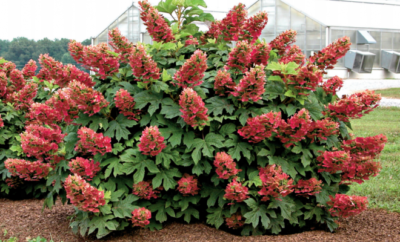
Reproduction methods
Most often, the plant is propagated by cuttings, dividing bushes, grafting (green layering) or seeds.
In order for the cuttings to take root in the best way, the procedure should be carried out around the second half of July. Strengthening lasts about a month, subject to the necessary conditions - providing a constant shade and temperature from + 16 ° C to + 20 ° C.
The hydrangea is bred by dividing the bush. At the beginning of April or at the end of October, it is dug up, divided into several parts so that about 3 buds remain on each process.
The most difficult method is the cultivation of shrubs by the sowing method, for this you must meet all the necessary conditions. The first stage will be the germination of seeds, for this they take a saucer and cotton wool, sprinkle seeds on the cotton wool and cover with another layer of cotton wool, pour boiled chilled water and wait for shoots. After the seeds should be placed in the soil of humus, peat, sand. Missing components can be replaced with forest soil. For room cultivation in a pot, the sprouts are covered with a jar and watered from a spray bottle, while it is best to keep them cool. When planted on an industrial scale, the seeds are scattered into boxes and covered with glass until germination.
For open ground, use hatched seeds or dry ones. Seeds are scattered over the garden bed and slightly trampled with a palm, then sprinkled with sand and a layer of soil about 1 cm.By autumn, the seedlings reach a height of up to 40 cm.
Planting of oak-leaved hydrangea in the middle lane is carried out in late spring, in southern regions with a temperate climate - in the fall. The soil should be chosen neutral or slightly acidic, necessarily well loosened and with a lot of organic material. To begin with, a hole is dug, twice the diameter of the earthen clod of the seedling. Organic, peat and mineral fertilizers mixed with the soil are introduced. We take out the seedling together with the earth from the pot, carefully free the roots from the soil and straighten them, lower them into the prepared hole and cover them with earth mixed with humus. We crush the soil, water the plant and mulch with needles or bark.
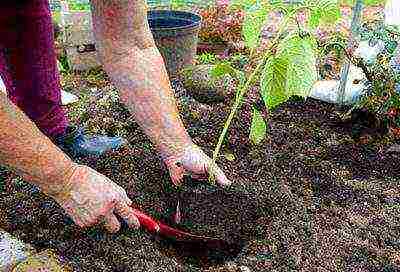
Care, fertilization and wintering
For rapid growth and a royal crown with flowers, the hydrangea bush must be properly fertilized with various organic and mineral fertilizers based on iron and magnesium. It is important to carry out complex feeding twice a year: at the time of planting and during active growth.
The spring period is the beginning of the fertilization of shrubs. The following composition is introduced into the soil: urea (20 g), potassium sulfide (40 g) and superphosphate (30 g) per 1 m2. Watering is worth a couple of times a week, 2 buckets for each plant.
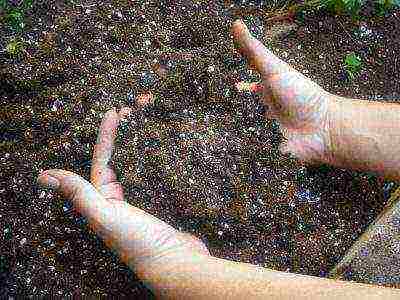
Towards the end of October, the time of the first frost comes, in this regard, it is worth thinking about preserving the hydrangea and protecting it from frost. Young shrubs are covered with dry soil. Second-year bushes are pressed to the ground and covered with special material or roofing material. Mature plants are carefully tied and packaged in the same material, such as spunbond.Next, a shelter is erected from a metal mesh of a cylindrical shape at a distance of about 30 cm from the bush. Using dry foliage from the garden, which is in abundance in autumn, fill the formed space between the hydrangea and the net. In early April, when the above-zero temperature is established, the frame with foliage is removed, and then the shelter is also removed.
The first year plant is transplanted into a pot and placed in a warm place. By mid-December, the leaves of the bush fall off, and it goes into hibernation. At this time, it should be sent to a dark room and less watering. Revitalization begins in April - buds wake up on the branches of the bush. During this period, the plant must be placed on a window so that there is enough light, and watered with a supplement diluted in water. It is worth returning the hydrangea to a permanent place at the end of May, when the soil is finally warmed up.
To maintain health, crown and silhouette formation, powerful flowering and rejuvenation, the hydrangea should be cut off. The oaky variety requires pruning according to the classical scheme, since it blooms on the shoots of the current year. The initial pruning of a young plant is required after a couple of years. During this time, the hydrangea will acquire a powerful root system and get stronger.
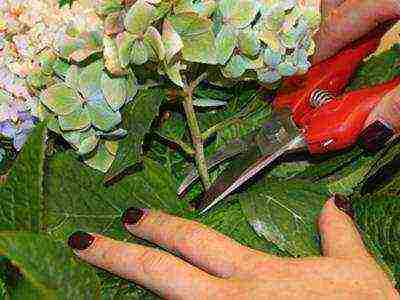
Diseases and pests
The culture is rarely affected by pests and diseases, but the most common are fungal diseases - gray rot, downy mildew, chlorosis.
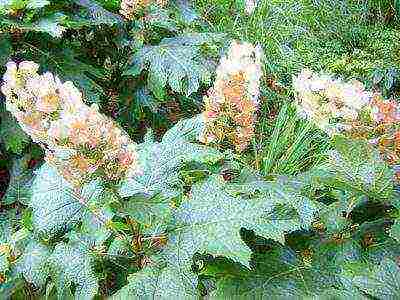
Downy mildew (downy mildew) appears when the treatment against the disease is carried out at the wrong time, fatty yellow spots appear on the leaves, which over time acquire a more saturated color and increase in size. To get rid of downy mildew, they resort to spraying with a solution: 20 g of copper sulfate and 200 g of laundry soap are dissolved in 10 liters of water.
On alkaline soil, hydrangea suffers from chlorosis - yellowing of the leaves. Treatment consists in feeding the plant with solutions with iron salts and watering with soft water. A good option for combating chlorosis is spraying with a solution of potassium nitrate (40 g) and ferrous sulfate (40 g), diluted in 10-15 liters of water.
Among insects, the most common pests are: aphids, pointed noses, spider mites, weevils and snails. They should be dealt with immediately after detection, resorting to insecticides. Delay can cost the life of the plant.
At the moment, the shrub has gained great popularity and is increasingly included in the flower collections of professional gardeners.
Hydrangea is a good preparation for dry bouquets, its flowers are not destroyed and practically do not lose color. The inflorescences are cut when they acquire the desired color. Get rid of the leaves on the twigs and hang in a darkened, well-ventilated place with the inflorescence down, one piece at a time. After a couple of weeks, the already dry shoots are placed in a vase or used in compositions.
And a little about secrets ...
The story of one of our readers Irina Volodina:
Especially depressing for me were the eyes, surrounded by large wrinkles plus dark circles and swelling. How to remove wrinkles and bags under the eyes completely? How to deal with swelling and redness? But nothing ages or rejuvenates a person as much as his eyes.
But how to rejuvenate them? Plastic surgery? Recognized - not less than 5 thousand dollars. Hardware procedures - photorejuvenation, gas-liquid pilling, radiolifting, laser facelift? Slightly more affordable - the course costs 1.5-2 thousand dollars. And when to find all this time? And it's still expensive. Especially now. Therefore, I chose a different way for myself ...
Read the article >>
Oak-leaved hydrangea is a large shrub, reaching 2 meters in height. It has a straight lignified trunk and a shallow branched root system. It differs from other species in the unusual shape of the leaves. They are not whole, like most hydrangeas, but 7-lobed, reaching 25 cm in length. They have a rough surface, sharp carved edges and resemble oak leaves.In autumn, the leaves turn from green to dark purple.
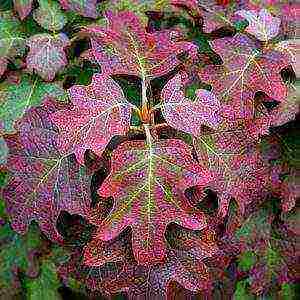 Oakleaf hydrangea blooms from early summer to autumn. On annual shoots, paniculate conical inflorescences are formed, reaching 30 cm in length. There are small white flowers on them.
Oakleaf hydrangea blooms from early summer to autumn. On annual shoots, paniculate conical inflorescences are formed, reaching 30 cm in length. There are small white flowers on them.
In general, the shrub is a hardy plant. But in the northern regions, during harsh winters, the shrubbery can freeze. Therefore, a prerequisite for caring for a plant is to shelter it from the cold in winter.
In combination with other plants, hydrangea will be a wonderful decoration for any garden. And thanks to its decorative effect, it is perfect for creating bright and colorful photos.
Oakleaf hydrangea varieties
The most common plant varieties are:
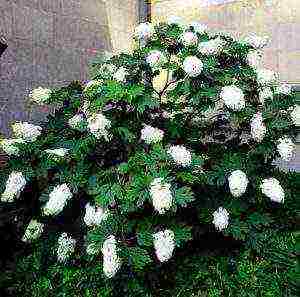 Hydrangea oakleaf snow-white domes is a beautiful deciduous perennial shrub up to 2 meters high. It has pubescent leaves up to 20 cm long with a varying color from whitish to dark green. This variety is distinguished by abundant flowering with dense inflorescences. It tolerates frost and drought quite easily.
Hydrangea oakleaf snow-white domes is a beautiful deciduous perennial shrub up to 2 meters high. It has pubescent leaves up to 20 cm long with a varying color from whitish to dark green. This variety is distinguished by abundant flowering with dense inflorescences. It tolerates frost and drought quite easily.
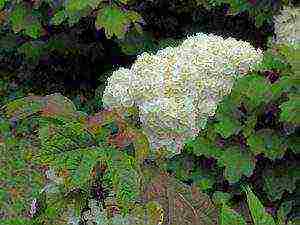 Hydrangea oak-leaved harmony is a perennial shrub, reaching a height of up to 2 meters. It has reddish shoots with 3-7 lobed leaves, which turn reddish or orange in autumn. Inflorescences are very large, snow-white, reaching 30 cm in length.
Hydrangea oak-leaved harmony is a perennial shrub, reaching a height of up to 2 meters. It has reddish shoots with 3-7 lobed leaves, which turn reddish or orange in autumn. Inflorescences are very large, snow-white, reaching 30 cm in length.
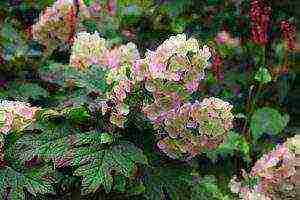 Oakleaf Hydrangea Applause is a shrub that grows up to 1.5 meters in height. It has rather large leaves, divided into lobes. In autumn, they change color from green to brown-purple with a slightly bluish tint. Semi-double whitish flowers are collected in large inflorescences. In winter, the shrub must be covered.
Oakleaf Hydrangea Applause is a shrub that grows up to 1.5 meters in height. It has rather large leaves, divided into lobes. In autumn, they change color from green to brown-purple with a slightly bluish tint. Semi-double whitish flowers are collected in large inflorescences. In winter, the shrub must be covered.
Planting and leaving
Novice growers consider hydrangea a capricious and difficult plant to care for. But experienced flower lovers argue that in fact the shrub is not very demanding and is suitable for everyone to grow.
Planting hydrangeas
When a stable temperature occurs, the plant is planted in the ground. It tolerates bright light well, but partial shade is the best place to plant.
- The soil for planting hydrangeas is prepared by mixing leaf, peat soil and coarse sand.
- The soil should be loose, rich in organic matter and slightly sour. You can acidify it with high-moor peat or fertilizers.
- The hydrangea pit is made slightly larger than the volume of its root system.
- Peat with fertilizers is introduced into the dug hole.
- Next, the plant is carefully removed from the pot, the roots are straightened, placed in a hole and covered with sleep.
- The soil is tamped a little, then watered with settled water.
- The area around the plant is mulched with sawdust or needles.
Further care
Hydrangea is a fairly moisture-loving plant, therefore, the main requirement for care is compliance with the correct watering regime. In hot periods, about 2 buckets of warm water are poured under all adult bushes 1-2 times a week. If the area around the hydrangea is mulched with peat, watering can be reduced.
Periodically, the soil around the plant is loosened for better air flow to the roots. It is also necessary to promptly remove faded shoots and dried stems with leaves.
Fertilizing hydrangea
To increase the duration of flowering, the plant is periodically fertilized with complex dressings every 2-3 weeks until July. To do this, use a solution of 20 g of urea, diluted in a bucket of water. When the plant has faded, special mineral fertilizers are used.
If the plant is fed too often, the shoots may not be able to withstand large inflorescences. Therefore, it is better to tie the branches.
Pruning hydrangea
Plants are pruned that have reached at least three years of age. In the spring, until the sap flow has begun, and the leaves of the hydrangea have not blossomed, all dry, damaged branches are removed. Only 3 pairs of buds are left on healthy shoots.
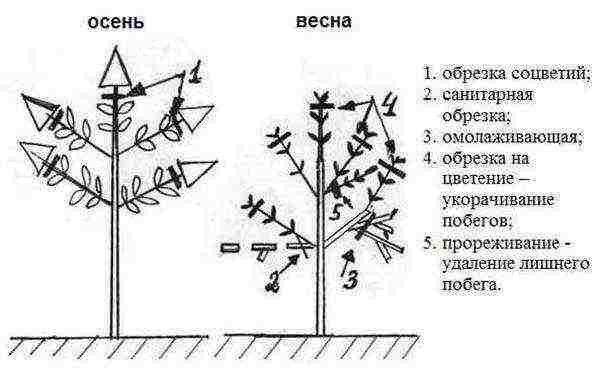
Growing from seeds
Hydrangea seeds are sown in autumn at a shallow depth.To do this, mix peat, leafy soil with coarse sand. The soil is slightly moistened and covered with foil. The substrate is periodically ventilated and kept slightly humid. During germination, the air temperature should be 15-20 ° C.
After germination of seedlings, the film is removed, and when the first pair of leaves appears, the seedlings dive into more spacious containers. In order for the hydrangeas to grow stronger, they are taken out into the air during the day.
Propagation of hydrangea by cuttings
The shoots remaining after pruning can be successfully rooted:
- for this, the shoot is cut into small parts, leaving two nodes on each at a distance of 2 cm from the cut;
- then the cut cuttings are planted in the prepared soil no deeper than 2 cm and watered with warm water;
- cover the pot with a film or glass jar;
- further care of the cuttings consists of maintaining a stable soil moisture by spraying and periodic ventilation;
- after rooting, young hydrangeas are planted in a permanent place.
Hydrangea wintering
Before the first frosts, it is advisable to transplant young immature plants into pots and keep them warm. With the onset of winter, a dormant period begins in the hydrangea contained at home. It is moved to a darkened place and watering is reduced. In April, the plant wakes up, it is transferred to the light. Gradually begin to water with warm water with the addition of fertilizers. In late spring, the plant is planted in its usual place.
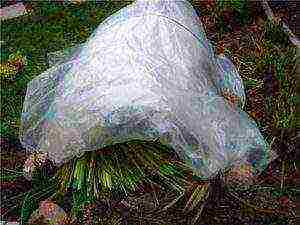 In regions where winter is not very harsh, young bushes are covered with earth. Older plants must be covered in mid-late autumn. To do this, the branches are bent to the ground and covered with spruce branches or a special material such as lutrasil or roofing felt. A layer of peat is poured on top, covered with a film and pressed down with a load. Hydrangeas are opened in spring when the weather is stable.
In regions where winter is not very harsh, young bushes are covered with earth. Older plants must be covered in mid-late autumn. To do this, the branches are bent to the ground and covered with spruce branches or a special material such as lutrasil or roofing felt. A layer of peat is poured on top, covered with a film and pressed down with a load. Hydrangeas are opened in spring when the weather is stable.
Diseases and pests
The plant has a fairly strong immunity against diseases. But still, with not entirely correct care, hydrangea can be susceptible to some diseases. The most common are gray rot, fungal infection. The main cause of such diseases is high soil moisture. If the disease has not spread much throughout the plant, normalizing soil and air moisture can save the hydrangea.
If the leaves turn yellow and fall on the bush for no reason, this is a clear symptom of chlorosis. It can be caused by a deficiency of iron, magnesium or nitrogen in the soil. Chlorosis is eliminated by applying organic and mineral fertilizers, as well as getting rid of pests.
Insects such as aphids, weevils, spider mites can do great harm to your plants. Get rid of them with insecticides.
With timely watering, pruning and proper cultivation, oak-leaved hydrangea will delight you for more than one year with its beauty and lush flowering.
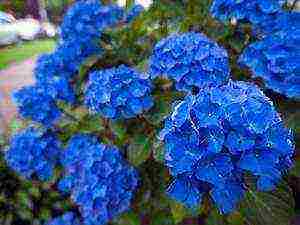 The tall, profusely blooming beauty hydrangea is the favorite of many flower growers. In addition to external beauty, hydrangea has other advantages. It easily tolerates wintering in the open field, and hydrangea flowers are pleasing to the eye from July to October.
The tall, profusely blooming beauty hydrangea is the favorite of many flower growers. In addition to external beauty, hydrangea has other advantages. It easily tolerates wintering in the open field, and hydrangea flowers are pleasing to the eye from July to October.
Garden hydrangea belongs to the hydrangea family. There are species not only bushy, but also in the form of trees and vines.
Hydrangea flowers have a lot of shades. The most common are white and purple. In Japan, hydrangea is called the "violet sun". Garden bushes this plant sometimes reaches three meters in height.
How to grow hydrangea
There are very few compact varieties that can be kept at home. This plant is a very large and loving space. When planting, they usually take into account the hydrangea's love for open areas and try to please her.
This sun-loving plant does not like shade and strong winds. If the hydrangea is in partial shade, the number of flowers on it decreases, in addition, it begins to bloom a little later. Ideal landing site - the eastern side, so that the shrubbery gets maximum sun in the morning.
Same
Planting a garden hydrangea.
Soil composition
Hydrangea has a unique ability - its color depends on the composition of the soil in which it grows. Hydrangea loves fertile clay soils, rich in humus. Poorly tolerates red soil soil. And hydrangeas are completely contraindicated - sandy lands. As for acidity, hydrangea turns out to be the brightest on acidic soils, while on neutral - blooms in faded shades... With alkaline soil, hydrangea leaves turn yellow and development slows down.
It is not for nothing that experienced gardeners advise to acidify the soil on which this plant grows, and treat the bush itself with iron chelate. Even 50 years ago, it was popular to bury nails or iron horseshoes under each plant.
Prepare the following fertilizer mixture for the bush:
They take equal amounts of forest soil, peat and humus. Urea, potassium sulfate and superphosphate - 30 grams of all components. It is advisable to dig up the earth under the spruce so that it is sour. Mix everything and use when planting hydrangeas.
Gallery: hydrangea (25 photos)
How to care for hydrangea in the garden.
Mulching
As already mentioned, this plant is very fond of moisture, it is not for nothing that it is called in Latin - Hydrangea, which translates as "a container with water". To keep moisture as long as possible, mulch the soil under the bush. In addition, mulching will protect against weeds and overheating. Use peat or bark, about ten centimeters thick.
The procedure is best carried out in May, when the soil has already warmed up.
Top dressing
Top dressing is necessary for all plants, and especially for flowers, because the formation and size of buds depends on the dressing.... Hydrangea is fed the first ras when landing and a second time at the beginning of summer. They use both mineral and organic fertilizers. From organic matter, bird droppings or mullein are suitable, and from chemistry: potassium nitrate and superphosphate.
You can do another top dressing at the end of July. Beginning in August, feeding is stopped so that the young branches have time to turn numb by winter.
In order for the resulting shoots to become stronger, they are sprayed with a solution of potassium permanganate. You can also purchase special fertilizers for flowers. Special formulations for hydrangeas contain the iron she needs so much.
How to change the color of the buds
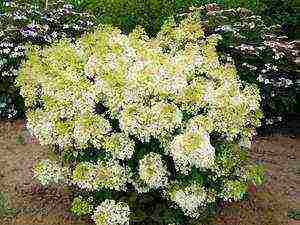 As already mentioned, the shades of hydrangea flowers depend on the minerals in the soil on which it grows. By changing it you can also change the color of flowers... Panicle hydrangea is usually pink or cream colored. If you add alkali to the soil, the color will change to raspberry or pink. On very acidic soil, the bush will delight with rich purple flowers.
As already mentioned, the shades of hydrangea flowers depend on the minerals in the soil on which it grows. By changing it you can also change the color of flowers... Panicle hydrangea is usually pink or cream colored. If you add alkali to the soil, the color will change to raspberry or pink. On very acidic soil, the bush will delight with rich purple flowers.
Blue buds are produced by varieties such as: Ramars, Freedom and Jomari.
To grow blue hydrangea, water the soil under the bush with a solution of iron salts or bury rusty iron nails. Thus, the hydrangea is blue.
Pruning
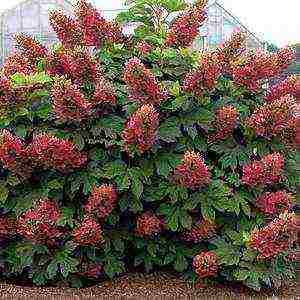 Caring for a garden hydrangea also involves pruning it. Each type requires an individual approach. If this hydrangea is large-leaved, prickly, liana-shaped or oak-leaved, then old branches are pruned to the beginning of strong buds.
Caring for a garden hydrangea also involves pruning it. Each type requires an individual approach. If this hydrangea is large-leaved, prickly, liana-shaped or oak-leaved, then old branches are pruned to the beginning of strong buds.
With paniculate and tree-like shoots, weak and already faded shoots are removed. Do not remove large quantities at once. Experienced gardeners advise to extend the procedure for two years. Branches that grow inside the bush are pruned.
The best time for pruning is autumn.... During this period, the movement of sap in the plant slows down, and it tolerates pruning well. What can not be said about spring. Pruning during the spring months can significantly slow down the growth and formation of inflorescences. In addition, in the spring, juice will stand out on the cuts. If you have already decided to prune in the spring, then carry out the procedure as early as possible before the onset of heat.
Thus, the basic rules of care are as follows:
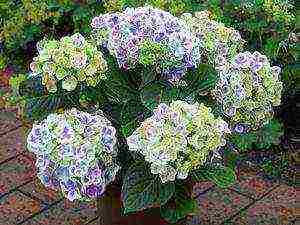 Watering as much as possible. The water should be warm and soft.
Watering as much as possible. The water should be warm and soft.- Do not plant a bush in the shade. The best place for the plant is in the east, where the sun's rays will caress it until lunchtime.
- Prune branches regularly and correctly. This will ensure a beautiful bush shape and abundant flowering.
- If you overdo it with organic fertilizers, then the plant will only begin to grow, forming few flowers.
- Try to cover the bushes for the winter. Even the most frost-resistant variety will not guarantee you a good winter.
- If the plant is still frozen, do not rush to part with it. Perhaps it will go away during the growing season.
- When planting seedlings, do not wash the roots from the earthy coma, as this can harm the plant. A small root with a developed bush indicates that the hydrangea was kept on drip irrigation and abundant fertilizers.
- Sometimes plants in nurseries are so overfed that, when they fall on open ground in the garden, they begin to wither. In such cases, the bush is gradually removed from the artificial state. At first, they continue to feed abundantly every two weeks, then the amount of fertilizer is reduced.
Seed propagation
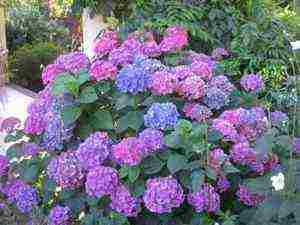 Hydrangea seeds can be germinated before planting in the garden, or you can do without prior germination. To germinate seeds, they are usually laid out on a plate, and covered with cotton wool on top. Add water and leave. If the seeds become slimy, they are washed and covered with new cotton wool and water is also added.
Hydrangea seeds can be germinated before planting in the garden, or you can do without prior germination. To germinate seeds, they are usually laid out on a plate, and covered with cotton wool on top. Add water and leave. If the seeds become slimy, they are washed and covered with new cotton wool and water is also added.
Once they are swollen, their planted in the ground... To do this, they take a box, peat, sand, humus and forest soil are poured into it. The seeds are not buried in the soil, but sown only lightly, with a thin layer on top. Then it is poured over and covered with glass.
As soon as the leaves begin to appear, remove the glass and ventilate the young plants.
In order to sow seeds directly into the ground, they are scattered and sprinkled with sand on top.
Views
Each variety has both advantages and disadvantages. Before buying a plant, it is advisable to analyze the possibilities of care.
- Hydrangea rough
A very unusual look. It differs from the rest in relatively small inflorescences of an interesting shape. Rough silvery leaves. The flowers are purple.
- Tree-like
The most popular of all types of hydrangeas. This high shrub, reaching three meters, can be found in many gardens and household plots. Treelike hydrangea blooms in white or cream color, but at first the flowers are greenish. The tree varieties are Annabelle, Invizible Spirit and Grandiflora.
- Paniculata
This species can be called a tree, its growth ranges from three to five meters in height. This plant lives for more than fifty years. The paniculate has very unusual inflorescences, at first they are painted green, then they turn pink, then brick and turn green again. The branches quickly stiffen because of what the plant takes the form of a tree... The most popular varieties are Vanilla Freise, Tardiva and Kuishu.
To create an organic tree from a bush, proceed as follows:
- A seedling is grown from a cuttings for two years
- One of the strongest shoots is left and the rest are removed.
- Shorten the shoot to a large bud
- They continue to grow until the tree reaches a meter in height
- With the help of pinching, form the crown of the future tree
- All but the five or six strongest shoots are removed. This procedure is carried out every year to form the correct crown.
- Hydrangea Invincibelle Spirit
A variety of tree hydrangea that originated in the United States. Invincibelle Spirit is translated as "invincible spirit". Very unpretentious and winter-hardy variety. If there is snow cover in winter, then additionally this hydrangea can not be covered.
Invincibelle Spirit blooms with pink flowers ranging from pale pink to a bright shade. The bush itself is of short stature, barely reaching one meter in height.
- Large-leaved
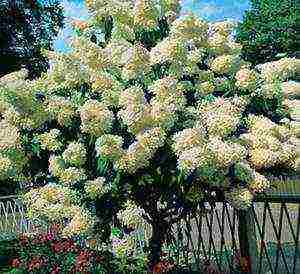 This species can grow in an apartment... It differs from the previous species in that it does not grow stiff, which is why protection for the winter is required. The flowers are collected in spherical inflorescences, the leaves of the hydrangea are bright green. The color of this bush will depend on the acidity of the soil. The most popular varieties are Rinata Steinger, Romance, Endless Summer and Expression. For the winter, the plants are bent to the ground, fixed with hooks and insulated with needles.
This species can grow in an apartment... It differs from the previous species in that it does not grow stiff, which is why protection for the winter is required. The flowers are collected in spherical inflorescences, the leaves of the hydrangea are bright green. The color of this bush will depend on the acidity of the soil. The most popular varieties are Rinata Steinger, Romance, Endless Summer and Expression. For the winter, the plants are bent to the ground, fixed with hooks and insulated with needles.
Propagate the broadleaf hydrangea using cuttings, layering or dividing the root of the bush.
- Dubolistnaya
Very thermophilic, but perhaps the most attractive of the rest of the hydrangeas. The inflorescences are very lush purple in color, although they grow white at first. Beautiful unusual shaped leaves.
- Omnipotent
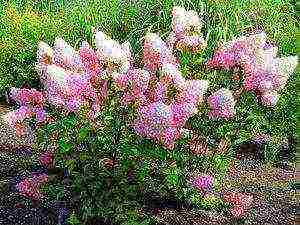 Tall, frost-resistant bush. Inflorescences are a little friable with a beautiful white-pink color. They usually bloom at the end of June. Most popular variety of this species - Bretschneider.
Tall, frost-resistant bush. Inflorescences are a little friable with a beautiful white-pink color. They usually bloom at the end of June. Most popular variety of this species - Bretschneider.
There are also varieties of radiant, petiolate and ashy. Separately, it is necessary to highlight the Sorgenta variety. The branches of this hydrangea do not bend at all, and when they try to bend they simply break. In order to insulate the bush for the winter, wrap the branches with paper or special covering material.
- Hydrangea Red Sensation
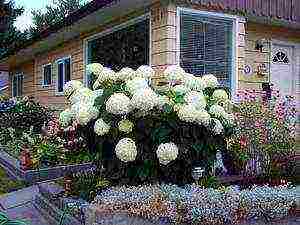 This red hydrangea originated in Holland. Closer to autumn, the inflorescences change color to burgundy, and the trunk of the plant is painted in the same color. This variety is quite frost-resistant, but nevertheless it is advised to cover it with a film for the winter. This variety propagates very easily with cuttings. To do this, they pour earth from the garden into the box, cut the cuttings, dip them in growth promoter and sit down. Each cutting should have no more than two leaves, and the top cut is treated with greenery.
This red hydrangea originated in Holland. Closer to autumn, the inflorescences change color to burgundy, and the trunk of the plant is painted in the same color. This variety is quite frost-resistant, but nevertheless it is advised to cover it with a film for the winter. This variety propagates very easily with cuttings. To do this, they pour earth from the garden into the box, cut the cuttings, dip them in growth promoter and sit down. Each cutting should have no more than two leaves, and the top cut is treated with greenery.
The cuttings are watered abundantly and protected from cold and drafts. Usually from one bush you can get up to twenty cuttings per year. No longer recommended as the bush may deteriorate.
Growing hydrangea
Attention, only TODAY!

